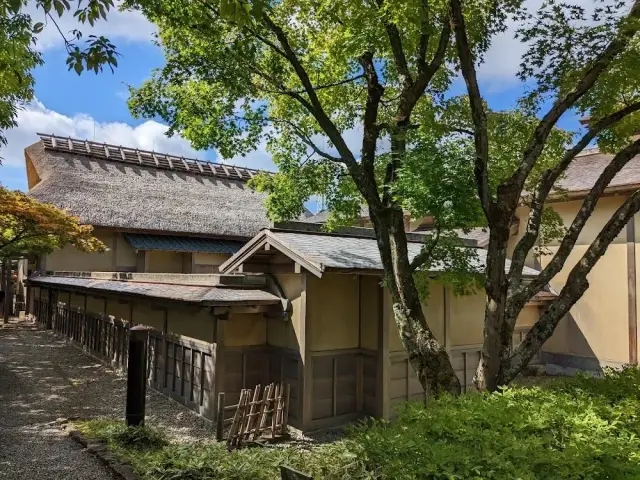https://www.dekitabi.com/itinerary/fukui-city-half-day-tour
Fukui Prefecture, nestled in the heart of Japan, offers a captivating blend of historical landmarks, serene gardens, and ancient shrines. Whether you’re a history enthusiast, nature lover, or cultural explorer, the region’s attractions promise a memorable experience. This guide delves into five notable sites in Fukui: Yokokan Garden, Fukui Castle, Sakaeno Yashiro Shrine, Moya Kuroyu Shrine, and Kitanosho Castle Ruins.
Yokokan Garden: A Haven of Tranquility

https://www.dekitabi.com/attraction/yokokan-garden
Yokokan Garden is a quintessential example of a traditional Japanese garden, renowned for its meticulous design and serene atmosphere. Originally built as a residence garden for the Matsudaira family during the Edo period, Yokokan Garden is now a public park that invites visitors to step back in time.
The garden features a beautifully landscaped pond, lush greenery, and elegant walking paths that meander through carefully curated landscapes. The seasonal changes bring unique charm to the garden, with cherry blossoms in spring, vibrant autumn leaves, and a peaceful winter blanket of snow.
Visitors can enjoy the traditional Japanese aesthetics embodied in the garden’s design, including a koi pond, a charming tea house, and strategically placed stone lanterns. The tranquil environment provides an excellent opportunity for relaxation and reflection, making it a must-visit destination for those seeking peace and beauty in Fukui.
Fukui Castle: Echoes of the Samurai Era

https://www.dekitabi.com/attraction/fukui-castle-ruins
Fukui Castle, or Fukui-jō, stands as a testament to the region’s storied past. Built in 1575 by the Matsudaira clan, the castle was an important stronghold during the Sengoku period. Though much of the original structure was destroyed during the Meiji Restoration, the castle’s reconstructed keep offers a glimpse into its former grandeur.
The castle grounds are home to several historical structures, including the impressive stone walls and moats that have survived through the ages. The Fukui Castle Museum, located within the castle grounds, provides fascinating exhibits on the history of the castle and the samurai who once inhabited it.
Exploring the castle offers a chance to appreciate traditional Japanese architecture and military history. The panoramic views from the castle keep afford visitors a breathtaking perspective of Fukui city and its surrounding landscapes.
Sakaeno Yashiro Shrine: Spiritual Sanctuary

https://www.dekitabi.com/attraction/sakaenoyashiro-shrine-fukui
Sakaeno Yashiro Shrine is a revered Shinto shrine dedicated to the deities of agriculture and fertility. Established over a thousand years ago, this shrine is a serene and sacred space where visitors can engage in traditional Shinto practices and experience the spiritual essence of Japan.
The shrine is known for its distinctive architectural style, which includes a charming torii gate, a main hall, and a peaceful forested setting. The lush greenery surrounding the shrine enhances its tranquil atmosphere, making it an ideal spot for quiet contemplation and spiritual reflection.
Seasonal festivals and rituals at Sakaeno Yashiro Shrine offer visitors a unique opportunity to witness traditional Japanese ceremonies and connect with local cultural practices. The shrine’s spiritual ambiance and historical significance make it a meaningful destination for those interested in Japan’s religious heritage.
Moya Kuroyu Shrine: A Hidden Gem

https://www.dekitabi.com/attraction/keya-kurotatsu-shrine
Moya Kuroyu Shrine is a lesser-known but equally fascinating site in Fukui Prefecture. This shrine is dedicated to the spirit of Kuroyu, a local deity believed to protect and bless the community. The shrine’s secluded location amidst lush forests contributes to its mystique and serene atmosphere.
The architectural style of Moya Kuroyu Shrine reflects traditional Shinto design, with a focus on simplicity and harmony with nature. The surrounding natural beauty, combined with the shrine’s historical and cultural significance, makes it a hidden gem worth exploring.
Visitors to Moya Kuroyu Shrine can enjoy a peaceful walk through the forested pathways, absorb the spiritual energy of the site, and appreciate the unique aspects of local religious practices. The shrine’s tranquil environment and historical context provide a distinctive experience for those looking to delve deeper into Japan’s spiritual landscape.
Kitanosho Castle Ruins: Echoes of the Past

https://www.dekitabi.com/attraction/kitanosho-castle-park
The Kitanosho Castle Ruins offer a fascinating glimpse into Fukui’s feudal era. The original Kitanosho Castle was constructed in the early 1600s but was eventually abandoned and fell into ruins. Today, the remnants of the castle serve as a historical site where visitors can explore the foundations, walls, and moats that once defined the castle’s grandeur.
The site is characterized by its impressive stone walls and expansive grounds, which provide insights into the castle’s former scale and significance. Walking through the ruins offers a sense of the castle’s historical importance and allows visitors to imagine life during the Edo period.
The Kitanosho Castle Ruins are particularly popular among history enthusiasts and photographers due to their evocative atmosphere and picturesque scenery. The site also hosts occasional events and exhibitions related to the castle’s history, adding an educational dimension to the visit.
Conclusion
Fukui Prefecture’s Yokokan Garden, Fukui Castle, Sakaeno Yashiro Shrine, Moya Kuroyu Shrine, and Kitanosho Castle Ruins each offer unique experiences that highlight the region’s rich history, cultural heritage, and natural beauty. Whether you are drawn to serene gardens, historical landmarks, or spiritual sites, these attractions provide a comprehensive view of Fukui’s diverse offerings. Exploring these sites will enrich your understanding of Japan’s heritage and provide lasting memories of your visit to this captivating region.


Leave a Reply